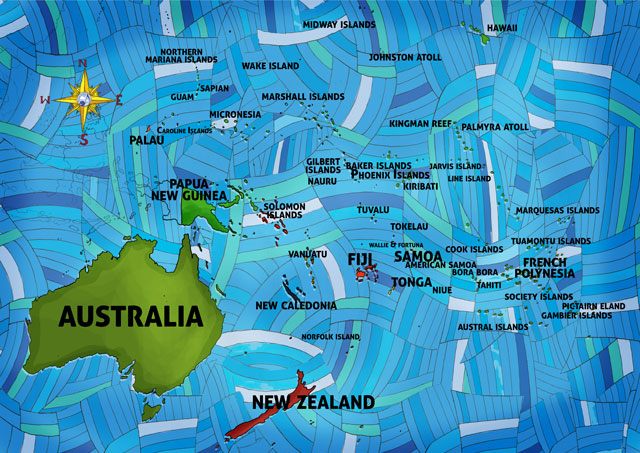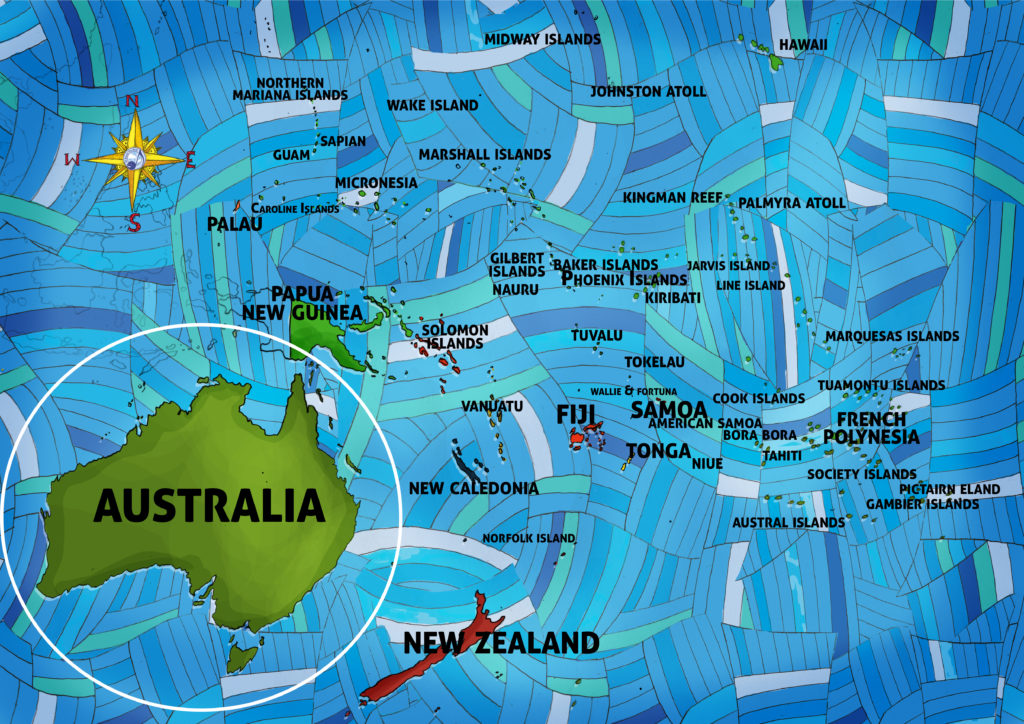Yesterday we met the bittersweet Tongan love song, “Ana Latu,” about spending one last night together before your love must go. In class when we sing it we sing, of course, but we also sway, bounce, wiggle and go ’round. It’s a beautiful song; sing along with me:
He ooi oi auee
Ana Latu
We walked on the beach
You loved me, I loved you
Our footprints in the sand,
When you held my hand
Became one path;
those in love will understand.
Tag Archives | Oceania
Ana Latu, We Love You
“Ana Latu” is a love song from Tonga, an island nation in Polynesia. The song is a lament, telling the tale of the final night we are able to spend with our beloved Ana. We cherish those last moments, and, whether Ana is departing for a trip abroad or whether she has left this world forever, we know we’ll miss her.
Bye Bye Oceania

Bravo – we made it! Over the last three months in our online class for kids we’ve traveled together thousands of imaginary miles, navigating endless (imaginary) Pacific seas in an imaginary, musical, dugout canoe. On our voyage we sang some of the world’s most harmonious songs, drummed the planet’s most stirring rhythms and experienced struggle and unending hope. We began in Australia, at the very start of the world, by following our Songline on a life-changing walk. In Papua New Guinea we battled with songs, in Fiji we sat as we danced, in New Caledonia we hopped while shuffling straw. In Guam we ate an orderly feast, in Kiribati we climbed trees for coconuts, in Tahiti we danced with booming hips. In the Cook Islands we sang in a seven part choir, in Hawaii we ate all sorts of poi and New Zealand we became so very strong. This season we celebrated life, the bluest of blue waters and the bluest of blue skies.
Let’s take one more week to bounce around Oceania and the Pacific Islands, making beautiful music together.
G’day Australia!
This week in our online class we enjoy ourselves tremendously while introducing Australia. Depending on your personal definition of what defines “a nation,” Australia is either one of the newest nations in the world or one of the oldest. European settlement of Australia really only began in the 18th century and Australia consolidated into a unified independent country as recently as 1901. On the other hand, when European explorers first “discovered” Australia in the 17th century and eventually colonized it in the 18th, almost a million people already lived there. The indigenous Aboriginal population had been present for over 40,000 years (some say up to 100,000), making the Australian continent one of the longest- continuously inhabited parts of the world. These million or so people were scattered about the land mass but had developed complex societies as well as spiritual and cultural practices based upon a deep connection with the land. The first British settlers, unable or unwilling to negotiate treaties with decentralized Aboriginal groups, declared the land “Terra Nullius” (essentially, land with no owner). European settlers brought diseases Aborigines had never encountered–the 1792 and 1822 smallpox plagues were especially devastating–and subjected the Aboriginal Australians to a seemingly never-ending series of forced re-settlements and other more lethal occurrences.
Over about eighty years an estimated 162,000 convicts were transported to the Australian colonies, 20% of whom were women. Most of these convicts were petty criminals and non-violent offenders. Convicts didn’t live in prisons but instead occupied small villages where they lived in independent structures, wore their own clothes and could even have their families come to join them; still, living conditions were deplorable. Convicts provided labor to build roads, bridges and develop other elements of the new colony’s infrastructure. From the 1850s until the early 1890s the discovery of gold in Australia led to a series of Australian gold rushes that attracted several hundred thousand immigrants. Most of these new colonists didn’t find gold and therefore had ample time on their hands to replace convicts as laborers on infrastructure projects. In the mid 1860s British policy changed and prisoner transports effectively stopped. Thwarted gold-diggers replaced them as Australia’s hungry, eager and independent working class.
Australia officially became a Commonwealth, albeit one still connected to the British Crown, on January 1, 1901.
More than Just the Stars
How the heck did they do it? How did Polynesian navigators, over the course of thousands of years, find their way from one little sand speck of land to another in the vastly vast vastness of 25 million square miles of ocean? This is before Google Maps, remember — even, if you can believe this, before MapQuest. How in the world did Pacific sailors set sail from one sliver of land in their log canoes and actually, on purpose, find their way to another? This video gives us a few hints.
Te Korero Maori
In the Pacific Islands, dancing is an expression of such joy. As we learn about cultures in Melanesia, Micronesia and Polynesia in our classes this season we may not quite learn how to dance like these performers in this video from the the Te Korero Maori Pacific Islands dance group, but we’ll happily exhaust ourselves trying.
Our first Sing Sing
This season in our online classes we’re going to celebrate so many cultures of Pacific Islands — singing, dancing and enjoying holidays that we meet in our classrooms. Fortunately for us, people across the Pacific revel in their rich multiculturalism too. Here, from the Solomon Islands, is an example of a light-hearted performance at a “Sing Sing,” a Pacific cultural celebration that inspires dancers to put their best feet forward as they compete with ensembles from other villages or islands. We will experience more Sing Sings as we sing forth around the region.
This Season We will Dance
Oh, we’re doing to dance this season as we travel through Oceania and the Pacific Islands. Pacific dance ensembles, like the one in this video from the French Polynesian Marquesas Islands, can be riveting. We will hop like Huli Wigmen in PNG, pilou pilou with swishing straw in New Caledonia, tahiri tamau (boom boom!) in Tahiti . . . .
Embarking on a Pacific Journey
Introducing Oceania and the Pacific Islands! Today in All Around This World’s online classes for kids we begin an adventure that will take us to one of the most naturally beautiful, geographically fantastical and musically exuberant regions of the world. Oceania and the Pacific Islands are a vast and – until the very recent advent of air travel – practically impenetrable array of thousands of islands that rise above the now-rising waters of the Pacific Ocean. The 300,000 square miles of land are strewn across millions of square miles of ocean. Water defines the life in all but the largest of the area’s land masses; the incredible distances between earthen peaks are as much a character in the region’s story as the histories and complex cultural customs of the peoples themselves.
For the next three months we will be traveling clockwise, more or less, around the region. We’ll start in Australia whose two-headed tale of ancient Aboriginal and comparably recent British population continues to unfold. There we’ll join Aboriginal youth on a metaphorical coming-of-age Walkabout. In Papua New Guinea we’ll compete as Huli Wigmen in a Sing-Sing, in Fiji we’ll use our hands to dance a story about the sea. In New Caledonia we’ll meet French colonizers and Kanak life-cycle celebrations and in Kiribati we’ll wake up before dawn to climb a coconut tree. In Guam we appreciate the saints with a feast, in Tahiti we shake our hips to a frenetic beat, and in the Cook Islands we sing harmony with a dozen disparate voices. In Hawaii we strike a chord for equality by eating pretend poi, and we end in New Zealand with a terrifying, and cathartic, dance. Over the course of the season we’ll learn two dozen songs that will introduce us to the rhythms of the deep wood drums that resonate beyond the boundaries of the shore and to melodies that rise from volcanic peaks to the endless sky.
Bill and Boyd go Chulu
Yesterday we sang a Fijian song, “Chuluchululu,” in our back yard with uncle Johnny. Today we take it somewhere relatively nearby but, culturally, entirely different — to New Zealand, where we sing it with our uncles Bill and Boyd.


